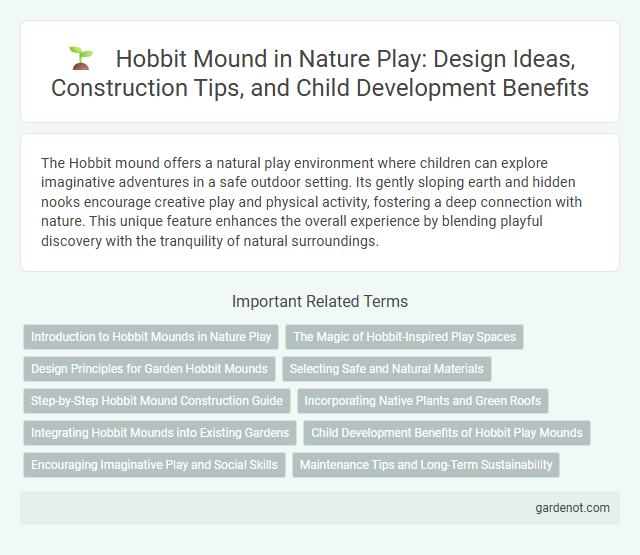The Hobbit mound offers a natural play environment where children can explore imaginative adventures in a safe outdoor setting. Its gently sloping earth and hidden nooks encourage creative play and physical activity, fostering a deep connection with nature. This unique feature enhances the overall experience by blending playful discovery with the tranquility of natural surroundings.
Introduction to Hobbit Mounds in Nature Play
Hobbit mounds are naturalistic play structures designed to blend seamlessly into outdoor environments, encouraging imaginative and sensory exploration among children. These earthen formations often feature gently sloping hills, tunnels, and small caves that mimic the whimsical underground homes described in folklore. By integrating natural materials like soil, plants, and rocks, hobbit mounds promote physical activity, creativity, and a deep connection with nature in play settings.
The Magic of Hobbit-Inspired Play Spaces
Hobbit mounds evoke a whimsical, nature-inspired play environment that encourages imaginative exploration and sensory engagement for children. These earth-sheltered structures blend natural materials with playful design, promoting outdoor learning and physical activity. Integrating Hobbit-inspired elements fosters creativity, environmental awareness, and a deep connection to the natural world.
Design Principles for Garden Hobbit Mounds
Garden Hobbit mounds incorporate naturalistic contours and earth-friendly materials to blend seamlessly with the environment, fostering imaginative outdoor play. The design emphasizes varied terrain with gentle slopes, hidden nooks, and integrated plantings that encourage exploration and sensory engagement. Strategic placement of tunnels and natural textures enhances physical activity while supporting ecological sustainability and child development.
Selecting Safe and Natural Materials
Choosing safe and natural materials for building a Hobbit mound ensures a healthy play environment that promotes children's connection with nature. Using untreated wood, natural stone, and non-toxic soil supports durability while preventing exposure to harmful chemicals. Incorporating elements like moss and native plants enhances sensory experiences and ecological balance within the play area.
Step-by-Step Hobbit Mound Construction Guide
To build a Hobbit mound, begin by selecting a gently sloping site and marking the desired mound shape with stakes and rope. Excavate the area to create a shallow pit, then layer soil and compost to form the mound, compacting each layer to ensure stability. Plant native grasses, mosses, and small shrubs on the surface to integrate the structure into the natural landscape and promote ecological benefits.
Incorporating Native Plants and Green Roofs
Hobbit mounds integrate native plants and green roofs to create immersive, eco-friendly play environments that support local biodiversity and reduce stormwater runoff. Using indigenous vegetation enhances habitat connectivity and requires minimal maintenance due to natural adaptation to the local climate. The green roofs act as natural insulation, improving energy efficiency while providing children with direct interaction with living landscapes.
Integrating Hobbit Mounds into Existing Gardens
Hobbit mounds seamlessly blend with existing gardens by mimicking natural landforms and enhancing biodiversity through native plantings. Their eco-friendly design supports local wildlife habitats while creating immersive, imaginative play spaces for children. Incorporating Hobbit mounds encourages outdoor exploration and strengthens connections between nature and play in family-friendly garden settings.
Child Development Benefits of Hobbit Play Mounds
Hobbit play mounds enhance child development by fostering imaginative play, sensory exploration, and gross motor skills through climbing, crawling, and balancing activities. These naturalistic structures encourage social interaction, problem-solving, and creativity in outdoor settings, promoting cognitive and emotional growth. Exposure to varied textures and natural elements on Hobbit mounds supports sensory integration and environmental awareness in early childhood development.
Encouraging Imaginative Play and Social Skills
The Hobbit mound provides an immersive natural setting that sparks imaginative play by encouraging children to create stories and adventures inspired by its whimsical design. This environment promotes social skills development through cooperative games, role-playing, and shared exploration, fostering communication and teamwork. Engaging with the Hobbit mound also supports emotional growth by allowing children to express creativity and navigate social interactions in a supportive outdoor space.
Maintenance Tips and Long-Term Sustainability
Regularly inspect the Hobbit mound for soil erosion and reinforce weak areas with natural materials like wood chips or mulch to maintain structural integrity. Manage vegetation carefully by trimming overgrowth and planting native species that stabilize the soil and enhance biodiversity. Implement a seasonal maintenance schedule to monitor drainage, prevent waterlogging, and ensure the mound remains a safe, sustainable play environment over time.
Hobbit mound Infographic

 gardenot.com
gardenot.com